Family : Apodidae

Text © Dr. Gianfranco Colombo

English translation by Mario Beltramini
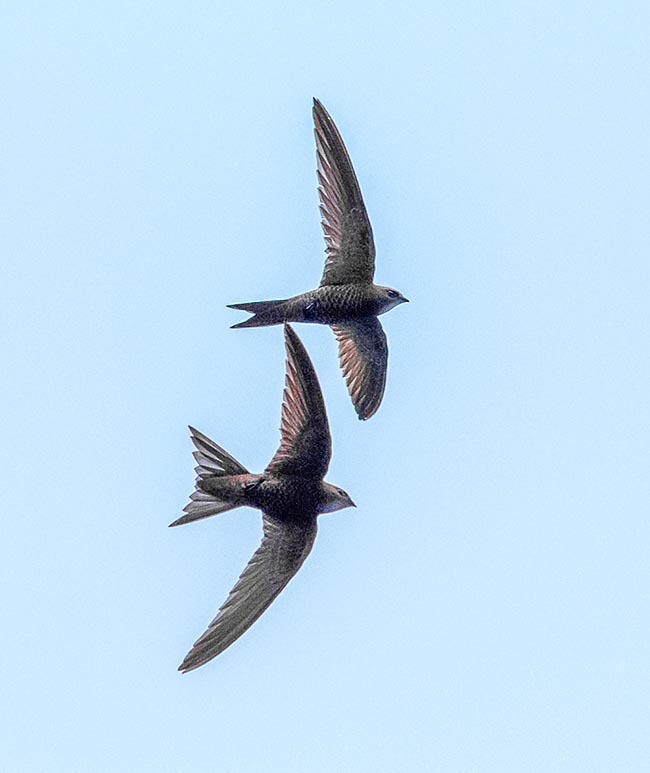
Couple of Pallid swift (Apus pallidus). Apart the amber shade of the plumage, it distinguishes from the Common swift (Apus apus) due to the Mediterranean habitat and its departure more than one month after that of the other species © Giuseppe Mazza
Almost 120 years had to pass before that an English ornithologist would classify the Pallid swift, distinguishing it from the Common swift, determined time before by Linnaeus in 1758.
This was done by G. E. Shelley during the drawing up of his book “Birds of Africa” published with the help of Sclater after that the author was struck by a paralysis that made him unable to complete it.
Hence the deductions on the differences between these birds happened in the African territory, where this swift, like all the Palearctic ones, takes shelter during the wintering period.
The resemblance between the subjects is such that still now experienced ornithologists often remain in doubt when they observe, high, gliding in the sky, these birds and with difficulty they pronounce themselves about the name of the species.
The evolutionary convergence has led various species of birds to assume behaviours and morphologies similar to each other, even if maintaining genetic characteristics that often place them in different families but, as is the case of the swallows and the martins, in a different order.
The swifts, in fact, belong to the Apodiformes whilst the swallows are Passeriformes.
So, the Pallid swift (Apus pallidus Shelley, 1870) belongs to the order of the Apodiformes and to the family of the Apodidae and is one of the three species that frequent the European skies, together with the Common swift (Apus apus) and the Alpine swift (Apus melba). In this order are grouped also all hummingbirds and the mellisugas, totalling about 430 species gathered in 124 genera.
There is a lot of relevance between the Pallid swift and the Common and many are the characteristics uniting them; from the habitats to the type of feeding, from the migratory movements to the sites of reproduction, from the social behaviours to the morphology.
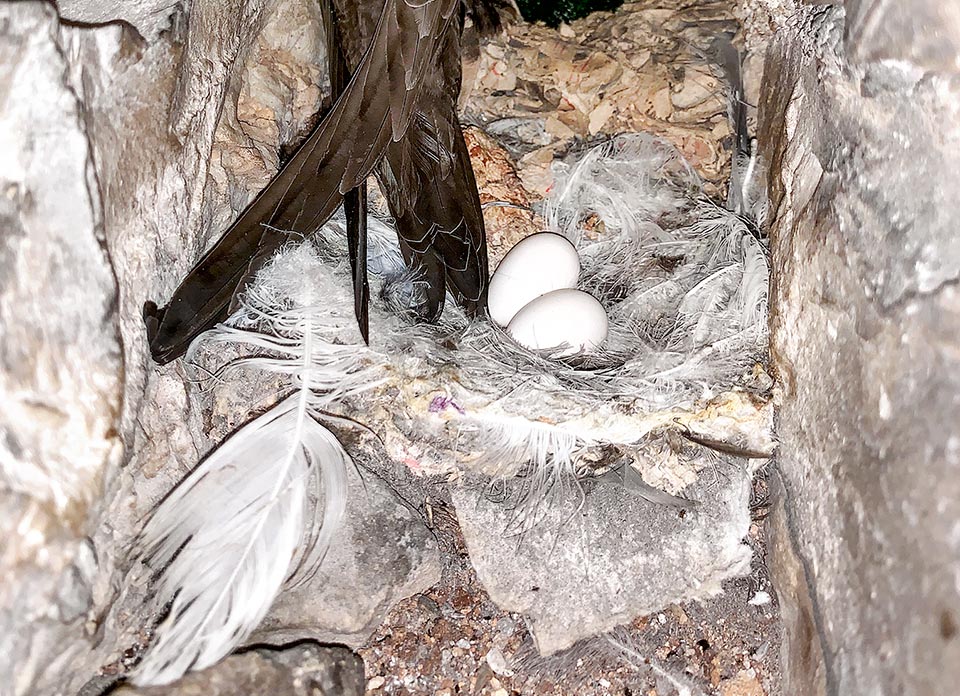
Nest with two eggs in a rocky cavity. Unlike the Common swift, the Apus pallidus does two broods per year © Giuseppe Mazza
Unique small differences, and probably these have been the indicators that have allowed the separation of the two species, concern the migration period and the number of the annual broods. All the rest, we can affirm this without shadow of denial, fits perfectly.
The etymology of the scientific binomen Apus comes from the Greek “a” = without and “pous” = feet, due to the reduced length of the legs and from the Latin “pallidus” for the discoloured black colour, at times amber, of its livery.
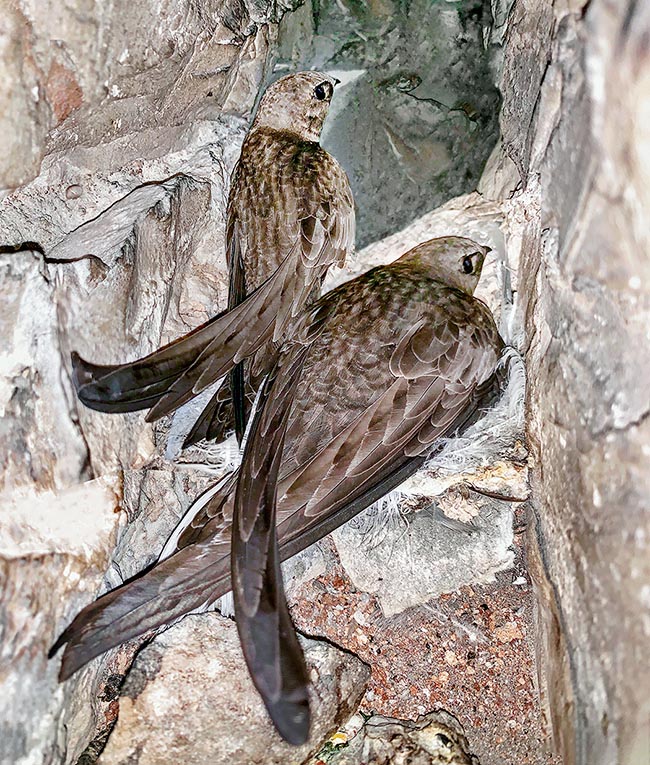
Male and female alternate lovingly hatching for about three weeks © Giuseppe Mazza
The Italian common name of Rondone, that is “big swallow” comes from the Latin term “hirundo” = swallow, even if others indicate Spanish “rondar” = to wander, due to their whrling flights around the nesting sites.
In Europe it is called Pallis swift in English, Fahlsegler in German, in Spanish Vencejo palido, in French Martinet pâle, in Portuguese Andorinhao pàlido and a nice Usuamatsubame in Japanese.
Initially it was thought that this bird was less common than what it actually is and that its territory was confined to some places well distinguished from the areas occupied by its closest cousin but in reality, as we shall see, its diffusion is quite ubiquitous and its populations sufficiently numerous even if not present in a continuous way.
The swifts are exceptional birds when flying and for the first two years of life they will never touch the soil and only when they will feel the necessity of nesting they will get down for the first time to touch the soil.
Often the reproductive active exceeds the second year of life, so the period of non-stop flight easily exceeds the biennium, in fact this bird, one of the most experienced in the avian activity, eats, drinks, mates and sleeping while flying.
The uniqueness rightly consists in these characteristics that lead it to cover unbelievable distances with an innate ease, far surpassing other birds that have done their life of the flight but that nothing have to compete with its numbers. We think to the petrels of the stormy oceans or to the Arctic tern (Sterna paradisaea) that holds the record among the migrants due to the length of its course that leads it to cover even 90.000 km per year.
However, the feats of Apus pallidus are incredible!
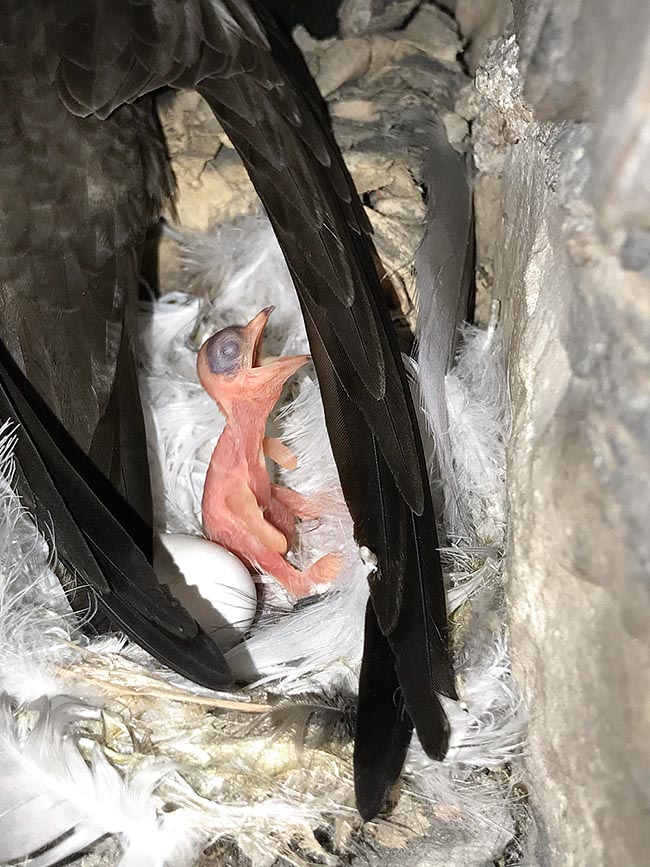
The first newborn, almost in maternal hug, appears to be already imploring for food © Giuseppe Mazza
This swift flies horizontally at an average speed of about 80 km/h with peaks that may exceed the 200 km/h and slowdowns to 50 km/h, as its conformation does not allow low speeds in order not to meet stalls and loss of aerial lift.
This means that during the 24 hours it may comfortably cover distances not under the 1.000 km and in the year not less than 350.000 km!
If we add then that for its longevity it may reach and exceed the 15 years of age, we can imagine what results can be reached.
Zoogeography
It is sufficient to make a comparison between the ranges occupied by these two swifts, to understand how much is limited that one of the pallid and how much vast is on the contrary that of the common.
An infinitesimal area of very few hundred of thousands of square kilometres where it stands, patchy, with a sparse presence and never important, limited to some areas with particular climate conditions, avoiding systematically others that display even very small variations to their usual habitat.
Whilst the common ranges between the latitudes going from 30° to 70° North, reaching the polar tundras and longitude from 0° to 130° East with an endless territory of many, many million of square kilometres, the pallid is limited between the 30° and 45° North and from 0° to 60° of longitudes East.
In Europe it exclusively occupies the Mediterranean coasts without passing the Alps and the Carpathians and only occasionally and sporadically the Pyrenees but in very limited measure and for quite few kilometres. It does not penetrate the Balkan peninsula as if it was an impassable barrier but from south, following the coats, it reaches the western shores of Anatolia and with few isolated populations, in the near East and the Persian Gulf.
Conversely, fairly substantial are the populations present on the north-western coasts of Africa up to the western coasts of Libya and proceeding east, with isolated presences up to the Nile Valley.
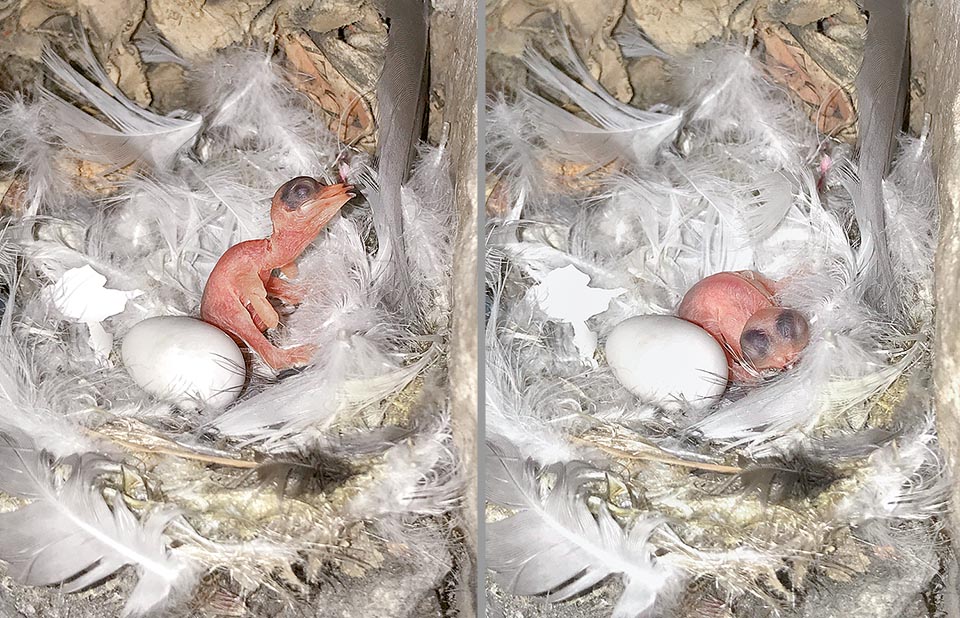
Then, exhausted, rests close to the rests of the shell and the second egg that soon will open © Giuseppe Mazza
All the populations of this species, Asian as well as European, hibernate in sub-Saharan Africa, never exceeding the Equator, opposed to its strict congener that proceeds well beyond reaching even the 30° South.
Apus pallidus spends usually six months in the winter quarters and six months in the nesting areas and is one of the insectivorous migrants that more delay their movements southwards, remaining at times in the natal places up to late October.
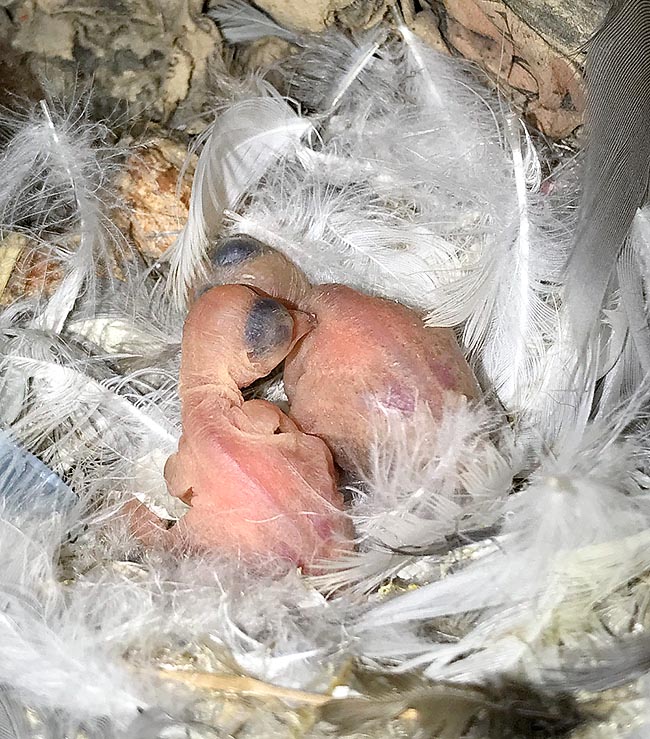
It seems incredible how, only 3 years old, the first-born, overfed, has grown up compared to the brother © G. Mazza
The comparison goes immediately to the Common swift that is, on the contrary, a migrant among the most latecomers in the arrival in the nesting sites (in May) and the hastiest in going back to the wintering quarters (already in July).
However it is quite difficult to give a geographic collocation precise and punctual to this bird, due to the previously mentioned recurring reasons.
First, the remarkable difficulty in distinguishing in flight these two species, often object of discussions even among the ornithologist observers themselves and then because these are two species particularly mobile that may cover hundreds of kilometres every day only to reach, if necessary, temporary feeding sources.
At times are observed presences in the high seas at hundreds of kilometres from the coast or gliding over high summits of the mountains and surely these sites are not their nesting sites.
The species is polytypic and displays some subspecies linked mainly to the characteristics of the occupied territories.
Apus apus pallidus that occupies a part of the southernmost stripe of the range, from the African coasts to the coasts of Pakistan, Apus apus illirycus typical to the Adriatic Sea coasts and Apus apus brehemorum, the most diffused that occupies the rest of the territory.
One last detail that renders the idea of how much are diffused these two species.
From a BirdLife International relevation of 2004 we read that the couples present in Italy were respectively about a maximum of 10.000 for the pallid and a maximum of 1.000.000 for the common on a European valued total of 39.000 couples for the pallid and 11.000.000 for the common.
Incomparable value and identifying the existing commingling between these two birds.
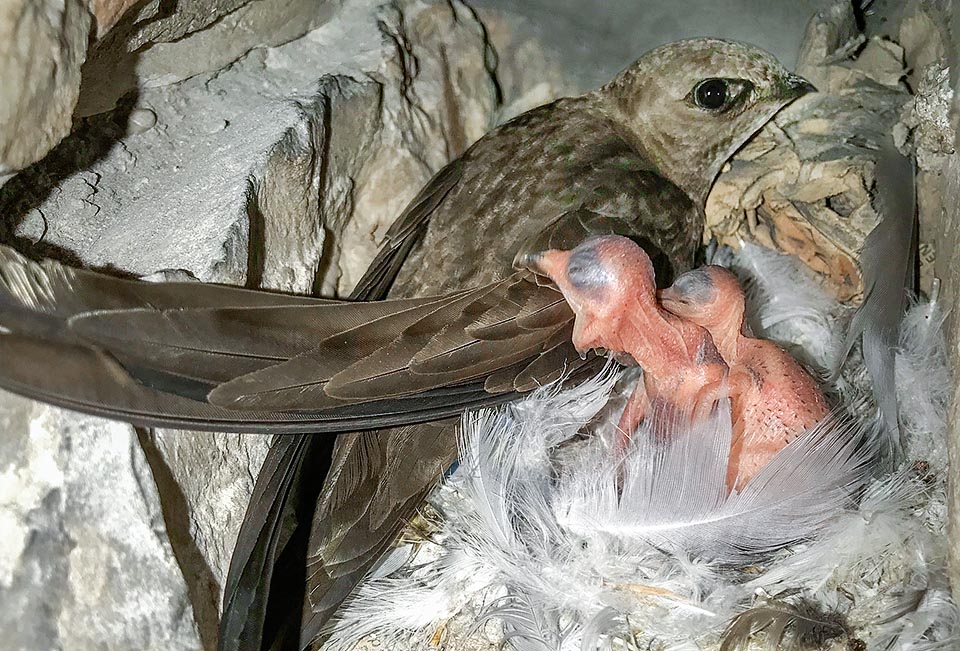
Now there are two mouths to feed. The parents coming and going with the chinstrap full of mosquitoes, ephemerals and other small insects collected in flight, is continuous © Giuseppe Mazza
It must be considered that the populations of both species enjoy good health, better, for the pallid it is observed a continuous increment of the populations especially in those located in the northernmost ranges that are conquering ever wider territories.
An example is the Po valley, in particular in the big town, where the presence and the settlement of this species are expanding more and more frequently.
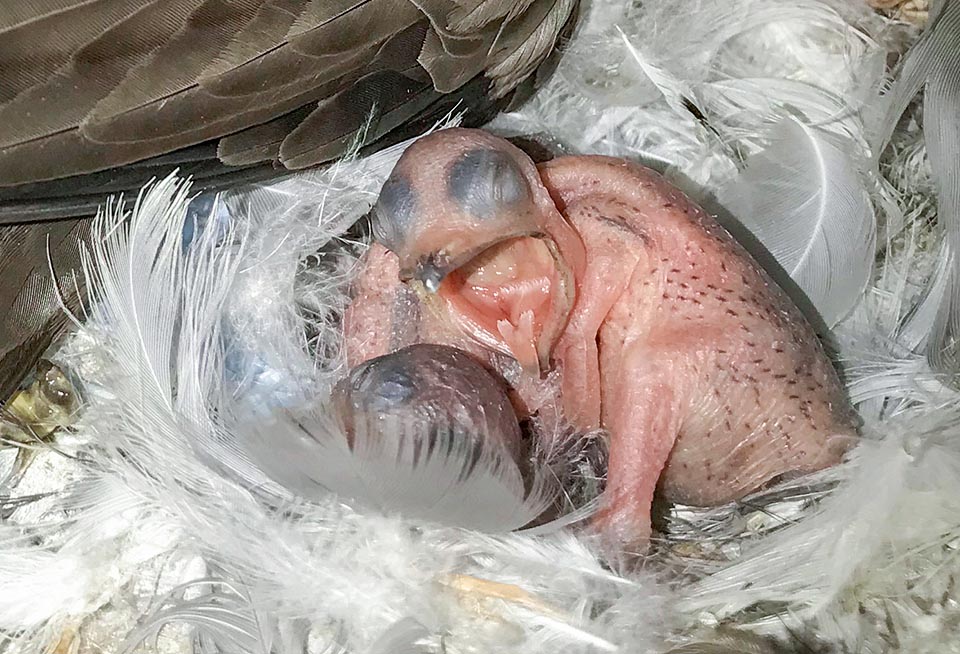
4 days old baby with open fauces. It has not yet seen the world , does not emit sounds but the mouth, well equipped, is really talking © Giuseppe Mazza
Ecology and Habitat
The habitat of this species is typically characterized by the Mediterranean climate or, at most, marine, with hot and dry summers and mild winters that preserve tendentially and in large part, the micro-fauna that will be the feeding at the base of these birds that extend their autumn presence more than due. On the other hand, we must reiterate that the variables that affect these habitats are not surely determined, in this case, by the only presence of these flying insects, when it is known that the swift can afford to follow the micro-fauna it eats everywhere and with absolute ease!
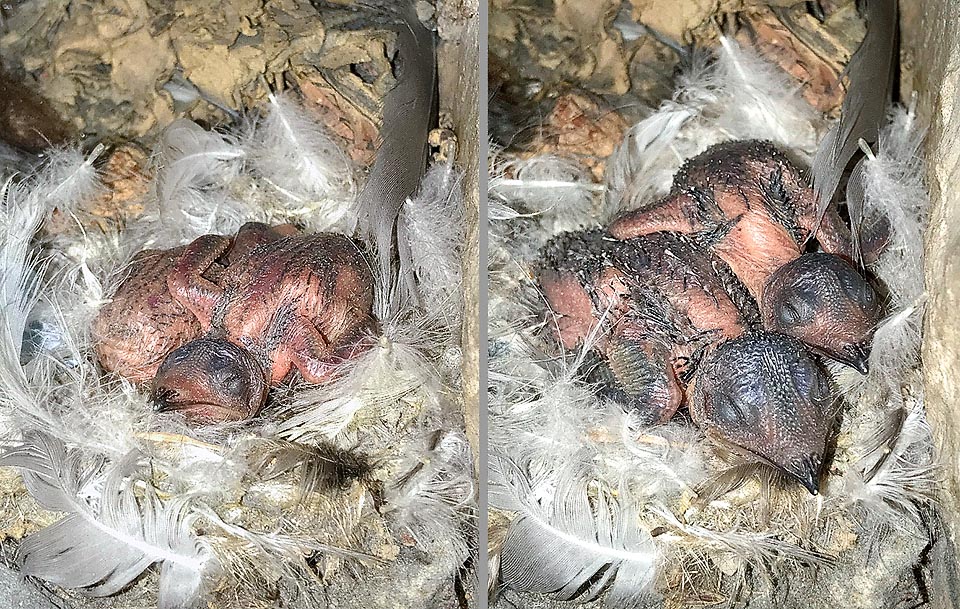
During the second week of life the feathers, that seemed a badly shaved beard, get out quickly and the babies are not naked any more © Giuseppe Mazza
Although logically decisive in this selection, it is to be remembered that often the choice of a habitat stands on the possibility of finding sites where to place the nest, prominent function for every living being as, missing them, the continuation of the species would be impossible.
We have often verified the effect of this variable, in particular during these last decades, during which, the building development has caused destructions of habitats once assiduously frequented by these flying insectivorous birds.
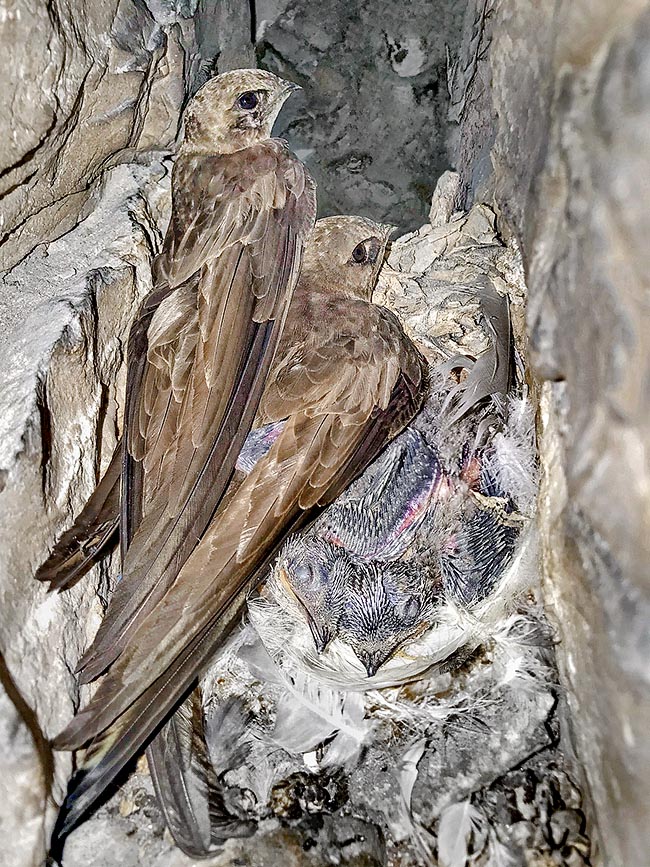
Parents look satisfied the progeny. Even if born for flying, the Apus pallidus spend often the night together. The couple is basically monogamous and it is thought to be such also for some years, considering that one of the main bonds keeping united the couple, is the fidelity to the nesting site that is repeatedly occupied year after year © Giuseppe Mazza
Old houses with gutters and falling roofs, once sites of nesting of swifts, have been modernized and renovated, driving away unconsciously and permanently colonies that were standing there since decades.
So much that today, only in cities endowed of old historical cantres with old buildings, ruins, castles and manors left unchanged by any modern renovation, we still may observe, those consistent colonies that our ancestors saw in their times.
Morphophysiology
The flight of the Apus pallidus is very powerful and also very agile and fluid.
There are no aerial acrobatics it is unable to perfectly perform, without a moment of hesitation and with the utmost ease.
Operations that the subject can perform even few some hours of that flight that will keep it on the air for two or three years without touching the ground!
Glides and turns, changes of course and zoomings, unlikely soarings and inexplicable tailspins, spaced with phases of rapid wingspan.
Each play is repeated by all swifts and in any moment of the flight, configuring, most probably, a sign of sociality and cohesion of the group, or, who know that we don’t discover it through study, maybe messages to indicate where the food is abundant.
Apus pallidus is so called due to a slight amber shade in the plumage that differs it from the common, bird uniformly darker. Conditions that can be verified with certainty only when we analyze a specimen seized and handled.
Any other consideration of morphological character on a flying sighted bird, is always subject to personal interpretations, conditioned by the good light conditions or by an extreme closeness in the observation or by the call it emits, very occasionally, during the flight.
The certainty is usually conditioned by the period of laying of the second brood and by the period it is sighted.
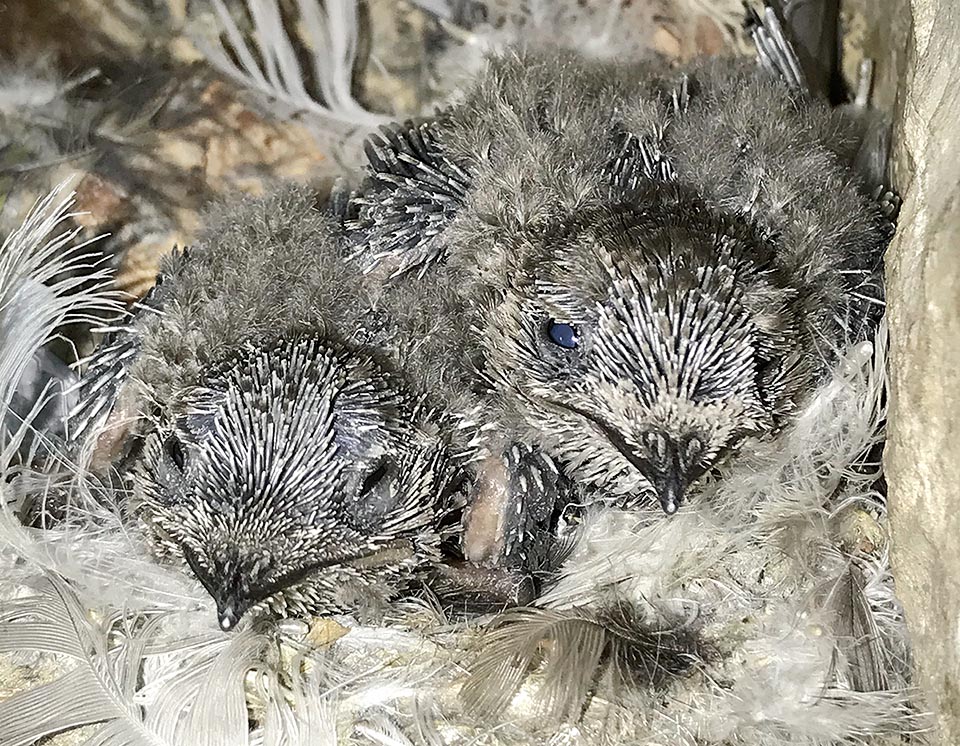
When about two weeks old, the kids, quite bristly, look like hedgehogs, but the eyes open and the down start to appear © Giuseppe Mazza
In northern Italy, the northernmost point of its range, the 10/15th of July can be the time limit of separation of the two species: after such date usually only the pallid is still present in the area.
What astonishes in this bird is the shape of the wings and their disproportionate length. The 50 g adults have even 40 cm of wingspan. A powerful motor that allows, even when at low engine speed, incredible velocities.
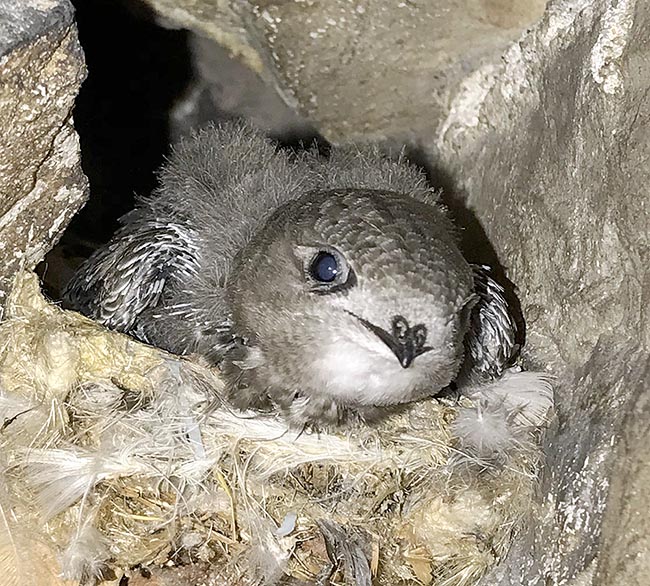
The days pass and the boldest appears on the home door. The young of Apus pallidus swift keep in the nest a very long time and need even six weeks to find the strength and the courage to jump outside © Giuseppe Mazza
The beak is very short. The mouth, very wide, is good for catching the insects in flight. They end up in a big sac in the chinstrap that allows to carry them, merged in hundreds, even for important distances, up to the nest. The tail is short, highly bi-forked, and when open we can note six couples of rectrices.
The legs are practically visible only when landing, when the animal clings strongly with the nails to the walls close to the nest. As occurs for the parrots, or the woodpeckers, the swifts in fact have zygodactylic fingers, with the two extreme opposable for a solid grasp.
Conversely, the legs of these birds are so short to render impossible the take off starting from the soil. The result is that the young fallen from the nest at the moment of their take off cannot get up; they will die, miserably, if they do not end before into the mouth of a cat.
But if the take off is successful, the Apus pallidus and the Apus apus appear to have a rather long life expectancy, amply exceeding the 12 years.
Ethology – Reproductive Biology
Nevertheless, it has been noted that more than its congener, this swift loves staying in family and often spends the nights together with the female during the hatching and the first days of life of the newborns. An uncommon nearness in these species of birds that seem to suffer when obliged to remain on the soil.
The whole is often conditioned by the outer climate conditions that not always offer the possibility of great booties at short range but it is probable that it’s more the affection between the partners to condition this choice.
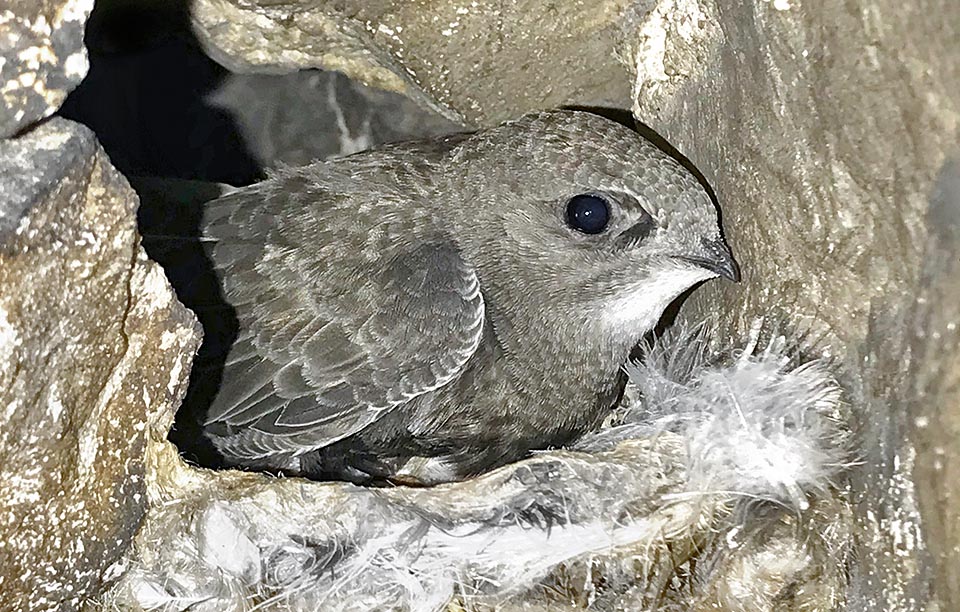
Overfed, at times the sons weigh more than parents. This, now grown, observes since days pensive the outer world © Giuseppe Mazza
Basically the couple is monogamous and it is thought that it is as such for some years, considering that one of the main bonds keeping united the couple, is the fidelity to the nesting site that is repeatedly occupied year after year. Upon the arrival or anyway a few days later or perhaps also during the migration, the couple gathers and the courting takes place immediately.
It is chosen a fissure or a tile or a hole in a wall of a construction or even a hole in a rock, in a scaffolder hole of an old building, in a crack in the retaining wall and even the now dry drain hole, of a road buttress on a heavily trafficked artery, at a height of very few metres. This knowing that these drain holes might reveal real hydraulic traps in case of heavy rains.
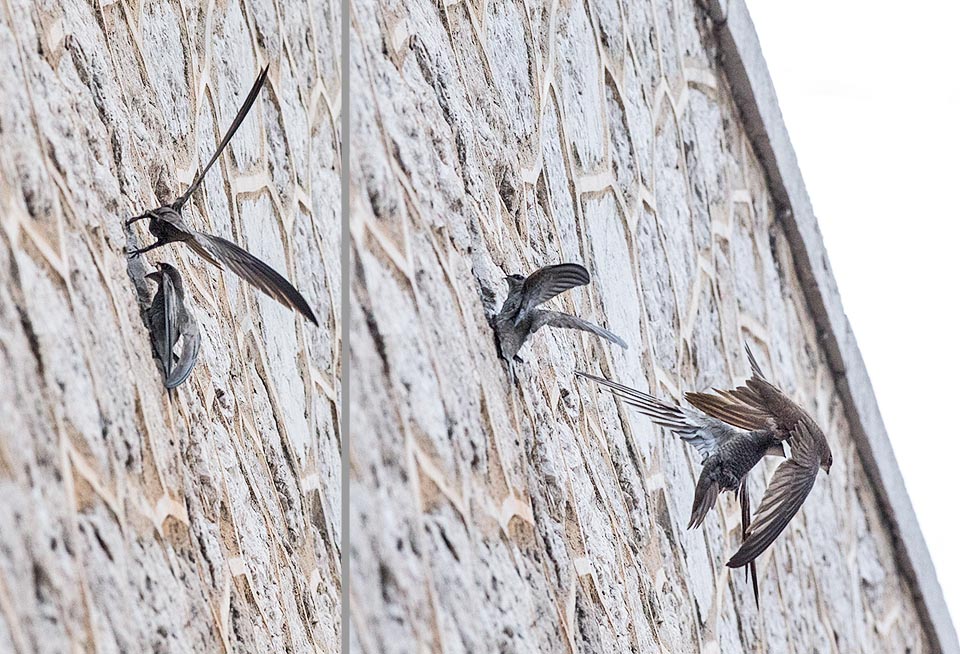
Last double goodbye beakful to the young clung to the rock, out from the nest, and parents go away fast. The meals had been reduced to oblige it to go out © G. Mazza
The important thing is that is present an even minimum internal capacity for the even if uncomfortable settling of a hatching bird and the two usual babies that will come to life.
Usually the nest stands in colonies of some couples at times isolated, for logistic and space necessities, by some tens of metres but the cohabitation during the normal daily functions is always guaranteed. On the other hand, have never been observed swifts flying alone but always in groups united and getting on well together as typical of a group social life.
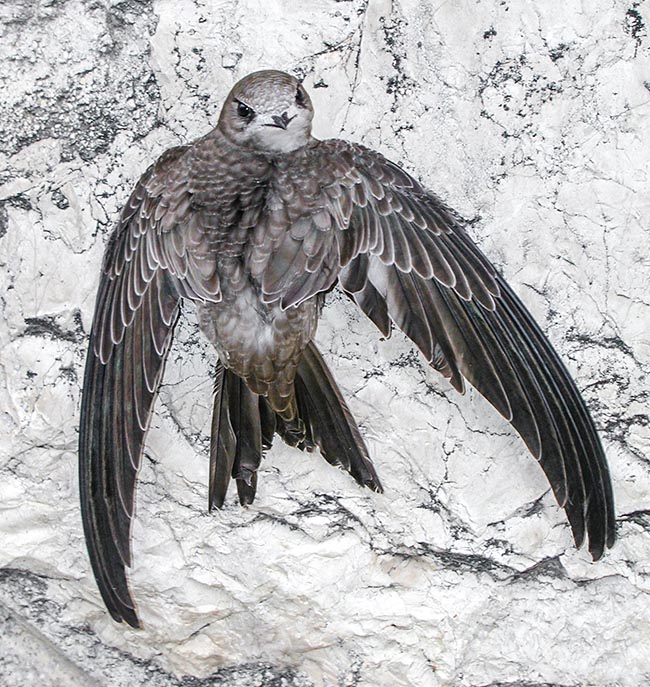
Fed, clung to the rock, it looks around for the jump in the vacuum. If unable to gain altitude, if falls to the ground, that means sure death because the short legs, even if beating the wings at most, these do not allow it to start flying © Giuseppe Mazza
We cannot talk of a true nest as it is simply a small mass of material collected flying and glued with saliva to form a small oval cup. Usually, they are soft feathers, dry blades of grass, pieces of various material: all what can be carried by the wind.
Usually are laid 2 eggs, rarely 3 and only exceptionally 4, hatched by both parents for about three weeks.
As said before, during the hatching and brood period, and in particular only the night, both parents remain at times on the nest keeping each other lovingly company, almost waiting for the birth of the babies, but at dawn one of them flies off leaving the partner alone until the moment of the turnover.
The duration of the hatching is of about 20 days and is done by both parents but the kids remain in the nest for long time and need even 6 weeks to find the strength and the courage for jumping out into the air.
The first brood is done a few days after the arrival and may correspond, depending on the location, from the end of March to the end of May whilst the second, around July, often displays abnormal delays that may carry the period of the flight off to late autumn, even by late August with a flight off by mid October.
The young are nourished with great quantities of very proteinic food that leads them to become at the moment of the flight off, even of dimensions bigger than those of the parents.
Once the right moment has come, the young are not more constantly fed, so to push them to abandon the nest looking for the parents and the food.
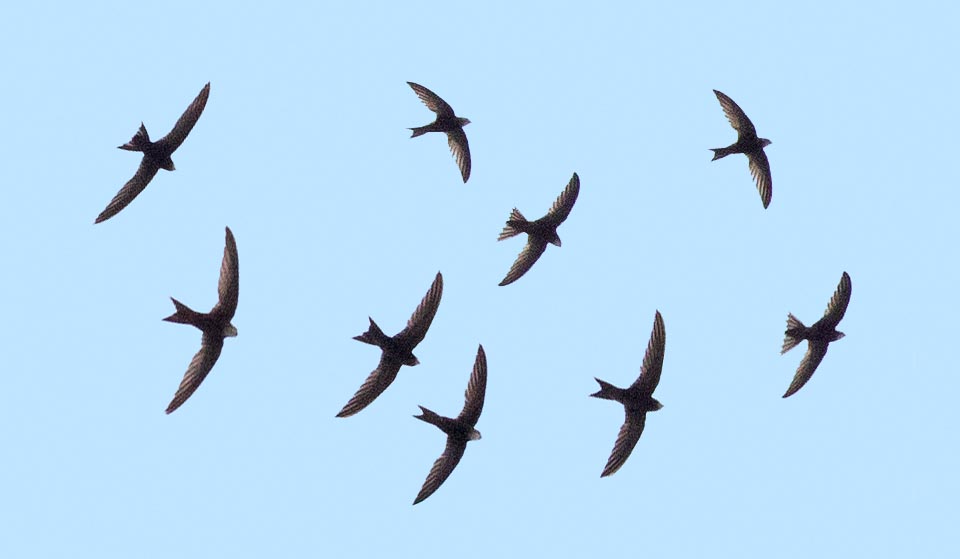
But this time it did go well and in a few seconds it has reached the adults, high in the sky, that reply to its joyful shout © Giuseppe Mazza
The baptism of the air is quite risky: a jump in the air without any experience and without the help and the experience of somebody and then away to the skies of the world. If you find a young swift on the soil, the only way to save it is to take it in hand and throw it from a high place. In a few seconds, after the jump, it will reach with shouts of joy its flight companions.
The populations are stable and since 2019 Apus pallidus appears as “LC, Least Concern” in the IUCN Red List of endangered species.
Synonyms
Cypselus pallidus Shelley, 1870.
